Optimal power allocation and capacity configuration based on variable cut-off frequency low-pass filtering for photovoltaic with hybrid energy storage system
IF 9.1
1区 工程技术
Q1 ENERGY & FUELS
引用次数: 0
Abstract
Photovoltaic (PV) power generation is affected by intermittent solar radiation, leading to fluctuations in output power and reducing the stability and reliability of PV systems. In general, a hybrid energy storage system (HESS) combined with a PV system is employed to smooth PV power fluctuation. However, the traditional algorithms for balancing the capacity of HESS, power fluctuations, and life cycle costs (LCC) remain challenging. To address this challenge, a modified method of variable cut-off frequency low-pass filtering (VFLPF) is developed to determine the capacity of battery and supercapacitor (SC) in HESS, as well as balance the relationship between PV power fluctuations and total energy system capacity (TESC). Additionally, ZE and Zp are adopted as metrics for evaluating the total energy system capacity and reference power, respectively, specifically employed to mitigate the maximum fluctuation rate (MFR) in PV systems. Moreover, the presented algorithm is validated by the photovoltaic module combined with the hybrid energy storage system (PVM-HESS) and the photovoltaic array combined with the hybrid energy storage system (PVA-HESS). In the presented PVM-HESS and PVA-HESS, the metrics ZE are respectively reduced by 2.65–2.94 % and 20–54.10 % compared to the traditional fixed cut-off frequency low-pass filtering (FFLPF) strategies of S.Ⅰ (cut-off frequency of 160 Hz) and S.Ⅱ (cut-off frequency of 750 Hz), while the Zp is reduced by 3.3–45.62 % and 3.31–78 %, respectively. The life cycle costs determined by the presented algorithm are reduced by 7.71 % and 11.10–21.52 %. Furthermore, a three-port DC-DC converter of 450 W is designed to connect the DC Bus with the PV module and the hybrid energy storage system, in which the MFR of PV output power is reduced by 23.77 %. Finally, a 20 kWp PVA combined with the hybrid energy storage system optimises power allocation and capacity configuration while reducing the MFRs throughout the year by 0.07–64.53 %. In conclusion, the presented algorithm and strategy are an effective technical solution for reducing total energy capacity and reference power when smoothing power fluctuations, as well as providing theoretical support for coordinated operation of storage energy equipment in a hybrid energy storage system.

基于变截止频率低通滤波的光伏混合储能系统最优功率分配与容量配置
光伏发电受到间歇性太阳辐射的影响,导致输出功率波动,降低光伏系统的稳定性和可靠性。通常采用混合储能系统(HESS)与光伏系统相结合的方式来平滑光伏发电功率波动。然而,平衡HESS容量、功率波动和生命周期成本(LCC)的传统算法仍然具有挑战性。为了解决这一挑战,提出了一种改进的变截止频率低通滤波(VFLPF)方法来确定HESS中电池和超级电容器(SC)的容量,并平衡光伏功率波动与总能源系统容量(TESC)之间的关系。此外,ZE和Zp分别作为评估能源系统总容量和参考功率的指标,专门用于缓解光伏系统的最大波动率(MFR)。并通过光伏组件与混合储能系统(PVM-HESS)和光伏阵列与混合储能系统(PVA-HESS)进行了验证。在PVM-HESS和PVA-HESS中,与S.Ⅰ(截止频率为160 Hz)和S.Ⅱ(截止频率为750 Hz)的传统固定截止频率低通滤波(FFLPF)策略相比,指标ZE分别降低了2.65 ~ 2.94%和20 ~ 54.10%,Zp分别降低了3.3 ~ 45.62%和3.31 ~ 78%。该算法确定的生命周期成本分别降低了7.71%和11.10 ~ 21.52%。在此基础上,设计了450w的三端口DC-DC变换器,将直流母线与光伏组件和混合储能系统连接起来,使光伏输出功率的MFR降低23.77%。最后,20 kWp的PVA与混合储能系统相结合,优化了功率分配和容量配置,同时将全年的MFRs降低了0.07 - 64.53%。综上所述,本文提出的算法和策略是在平滑功率波动时降低总能量容量和参考功率的有效技术解决方案,同时也为混合储能系统中储能设备的协同运行提供理论支持。
本文章由计算机程序翻译,如有差异,请以英文原文为准。
求助全文
约1分钟内获得全文
求助全文
来源期刊

Renewable Energy
工程技术-能源与燃料
CiteScore
18.40
自引率
9.20%
发文量
1955
审稿时长
6.6 months
期刊介绍:
Renewable Energy journal is dedicated to advancing knowledge and disseminating insights on various topics and technologies within renewable energy systems and components. Our mission is to support researchers, engineers, economists, manufacturers, NGOs, associations, and societies in staying updated on new developments in their respective fields and applying alternative energy solutions to current practices.
As an international, multidisciplinary journal in renewable energy engineering and research, we strive to be a premier peer-reviewed platform and a trusted source of original research and reviews in the field of renewable energy. Join us in our endeavor to drive innovation and progress in sustainable energy solutions.
 求助内容:
求助内容: 应助结果提醒方式:
应助结果提醒方式:


